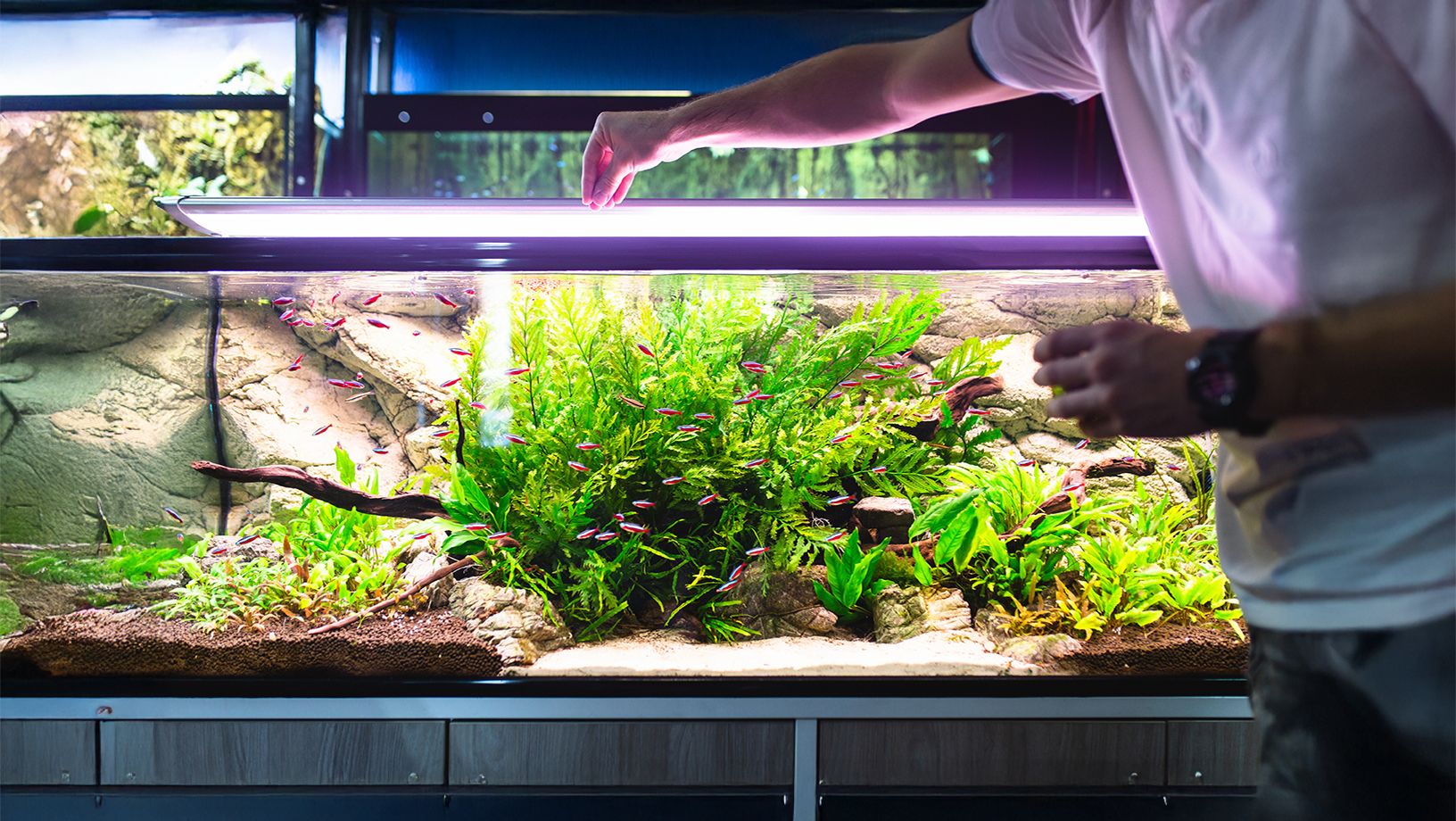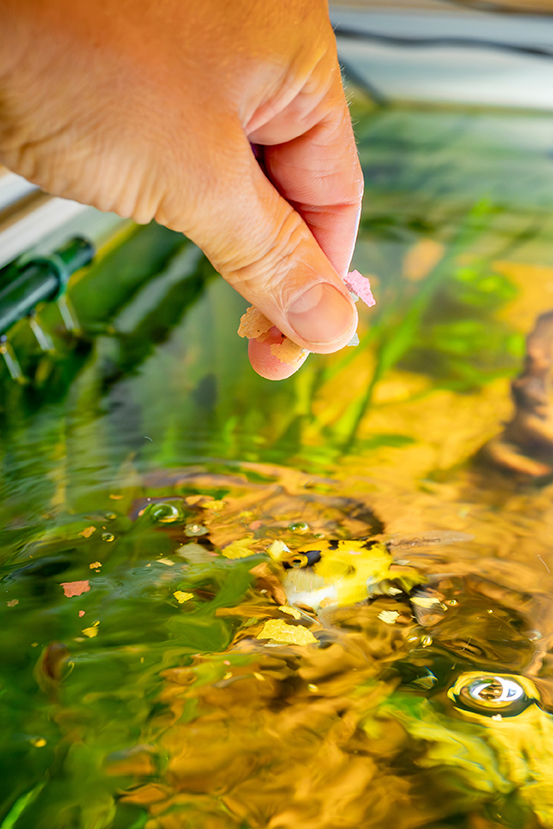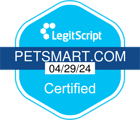Aquatic Pet Feeding Care Guide

What Should I Feed My Aquatic Pet?
Aquatic Pet Feeding Guide
Feeding your aquatic pets isn’t just about keeping them full, it’s essential to their health, happiness, and behavior. Use this guide to find out what and when to feed your fish, aquatic amphibians, and aquatic invertebrates, and how to avoid overfeeding.
What Should I Feed My Aquatic Pet?
The chart below can help guide you as you choose what to feed your aquatic pet. Most pets have a varied diet in the wild, so it's good to choose more than one type of food. These are recommendations and you may need to feed more or less.
Feed according to fish food package instructions and, after 5 minutes, remove any uneaten food. (Opt. = Optional, Juv=Juvenile)
Aquatic Pet Category | Species Specific Flake Food | Species Specific Pelleted Food | Dried Seaweed & Kelp | Frozen Shrimp & Worms | Frozen Krill & Fish | Live Ghost Shrimp & Feeder Fish |
African Cichlid | 1x Daily (juv) | 1x Daily (Adult) | 1-2x Weekly (Opt) | 1-2x Weekly (Opt) | ||
Angelfish | 1x Daily | 3x Weekly | ||||
Aquatic Amphibian | 1x Daily | 3x Weekly | ||||
Betta | 1x Daily | 1x Daily | 1-2x Weekly | |||
Coldwater Minnow | 1x Daily | 1-2x Weekly (Opt) | ||||
Danios, Tetras & Rasboras | 1x Daily | 1-2x Weekly (Opt) | ||||
Dwarf Cichlid | 1x Daily | 3x Weekly | ||||
Freshwater Shark | 1x Daily | 1x Daily | 1-2x Weekly | |||
Freshwater Shrimp | 1x Every Other Day | |||||
Goldfish & Koi | 1x Daily (Juv) | 1x Daily (Adult) | 1-2x Weekly (Opt) | |||
Gourami | 1x Daily | 1x Daily | 1-2x Weekly (Opt) | |||
Guppy | 1x Daily | 1-2x Weekly (Opt) | ||||
Large Bichir | 1x Daily | 1-2x Weekly (Juv) | 2x Weekly (Adult) | |||
Large Plecostomus | 3x Weekly | 1-2x Weekly (Opt) | ||||
Large South American Cichlid | 1x Daily (Juv) | 1x Daily (Adult) | 2x Weekly (Juv) | 2x Weekly (Adult) | 1x Monthly (Opt) | |
Loaches & Botias | 1X Every Other Day | 3x Weekly | ||||
Medium Central American Cichlid | 1x Daily (Juv) | 1x Daily (Adult) | 2x Weekly (Juv) | 2x Weekly | ||
Medium South American Cichlid | 1x Daily (Juv) | 1x Daily (Adult) | 2x Weekly (Juv) | 2x Weekly | ||
Molly, Platy, & Swordtail | 1x Daily | 1-2x Weekly (Opt) | ||||
Rainbowfish | 1x Daily | 1x Daily | 1-2x Weekly (Opt) | |||
Semi-Aggressive Other | 1x Daily | 1x Daily | 1-2x Weekly (Opt) | |||
Semi-Aquatic Crab | 1x Every Other Day | 1-2x Weekly (Opt) | 1-2x Weekly | |||
Small Algae Eater | 3x Weekly (sinking) | 1-2x Weekly (Opt) | ||||
Small Schooling Catfish | 1x Daily (sinking) | 1-2x Weekly (Opt) | ||||
Small to Medium Barb | 1x Daily | 1x Daily | 1-2x Weekly (Opt) | |||
Snail | 3x Weekly | 1-2x Weekly (Opt) | ||||
South & Central American Hybrid | 1x Daily (Juv) | 1x Daily (Adult) | Juvenile 2x Weekly | 2x Weekly |
Aquatic Pet Feeding Resources

General Aquatic Pet Feeding Best Practices
- Monitor your fish during feeding. Feeding time is one of the best opportunities to observe your fish. Make sure all fish are eating and behaving normally. Many fish will become active or swim to the front of the tank when they recognize their feeder.
- Feed a balanced, species-appropriate diet. A varied diet supports long-term health, improves color, and reduces stress. Use a mix of flakes, pellets, frozen foods, and vegetables based on the species.
- Replace fish food every three months. Vitamins in fish food begin breaking down as soon as the container is opened. Discard any unused food after 90 days and start a fresh container to ensure proper nutrition.
- Avoid overfeeding. Excess food leads to obesity in your fish. . Uneaten food breaks down into ammonia and poor water quality.
- Feed only as much as your fish can eat within five minutes. Start with less food and add more as needed.
- If you overfeed, do a partial water change and use a gravel vacuum to remove leftovers.
- Match food to natural dietary needs. Herbivores, carnivores, and omnivores all have different nutritional requirements. Refer to the care guides or ask a PetSmart associate for help choosing the right foods.
- Use caution with feeder fish. Feeder fish do not offer complete nutrition and should never be the sole food source for your fish. If you choose to use them, quarantine them in a separate tank and feed them a high-quality diet for at least two weeks before feeding them to your fish.
- Thaw frozen food before feeding. Place frozen food in a cup of aquarium water to thaw completely before adding it to the tank.
If you are going to have someone else feed your fish while you are away, pre-portion the fish food for each daily feeding. See the article on Automatic Feeders here.
When should I test my water quality?
- Fish are sluggish, near the bottom of the tank
- Fish are at the top, breaking the water to breathe
- Fish are not eating
- Sudden behavior changes in your fish
- Water is cloudy
- Water smells funny
PetSmart offers free water quality testing and one of our knowledgeable associates can help you get your system balanced.
When should I contact a veterinarian?
- Contact an aquatic veterinarian if you notice the following signs:
- Unusual swimming pattern
- Thinness or decreased appetite
- Abdominal swelling
- Inflamed or discolored skin/fins
- Fins clamped to sides of body
- Scraping body on rocks (flashing)
- Visible signs of illness or recent fish loss
If your fish show any of the signs above, we recommend using the “Find a Fish Vet” tool at fishvets.org or wavma.org to locate a qualified aquatic veterinarian in your area.
Ready to learn more?
This guide is a great starting place, but we encourage you to do more research on the individual species that you are keeping so that you can be as successful as possible with your aquarium!
Related guides:
Vet Assured™: Pets purchased at PetSmart are part of our exclusive Vet Assured™ program, designed by PetSmart veterinarians to help improve the health and well-being of our pets. Our vendors meet a high standard in caring for pets and screening them for common illnesses. This program also includes specific standards for in-store pet care.
The PetSmart Promise: If your pet becomes ill during the initial 14-day period, or if you’re not satisfied for any reason, PetSmart will gladly replace the pet or refund the purchase price.
Safety tips for you and your pet:
1. ALL ANIMALS can potentially carry viral, bacterial, fungal, and parasitic diseases contagious to humans. 2. Thoroughly wash your hands with warm, soapy water before and after contact with any pet or its habitat. 3. Adults should assist children with hand washing after contact with a pet, its habitat or aquarium water. 4. Always add a dechlorinator or water conditioner and bacteria starter to tap water before adding it to the aquarium. 5. Do not use soaps or detergents to clean aquarium or decor, since they are toxic to fish. For more information, visit petsmart.com, cdc.gov/healthypets, or contact your veterinarian.
This care guide contains general information for the proper care of your pet, but is not comprehensive and is not a substitute for veterinary advice or care. PETSMART and VET ASSURED are trademarks of PetSmart Home Office, Inc. © 2025 PetSmart. All rights reserved.
The PetSmart Promise: If your pet becomes ill during the initial 14-day period, or if you’re not satisfied for any reason, PetSmart will gladly replace the pet or refund the purchase price.
Safety tips for you and your pet:
1. ALL ANIMALS can potentially carry viral, bacterial, fungal, and parasitic diseases contagious to humans. 2. Thoroughly wash your hands with warm, soapy water before and after contact with any pet or its habitat. 3. Adults should assist children with hand washing after contact with a pet, its habitat or aquarium water. 4. Always add a dechlorinator or water conditioner and bacteria starter to tap water before adding it to the aquarium. 5. Do not use soaps or detergents to clean aquarium or decor, since they are toxic to fish. For more information, visit petsmart.com, cdc.gov/healthypets, or contact your veterinarian.
This care guide contains general information for the proper care of your pet, but is not comprehensive and is not a substitute for veterinary advice or care. PETSMART and VET ASSURED are trademarks of PetSmart Home Office, Inc. © 2025 PetSmart. All rights reserved.

